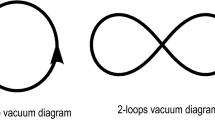Abstract
The contribution of the quantum vacuum to the energy-momentum stress tensor in Einstein's field equations is very large. The observed cosmos is not in agreement with such a large term; thus, we require the presence of a cosmological constant to cancel this term. We discuss why this constant cannot originate from a quantum field or the gravitational field. We propose that this constant is physical evidence of the structure of space. The physical structure of space gives space an existence independent of the existence of matter and radiation.
Similar content being viewed by others
References
Bjorken, J. D., and Drell, S. D. (1985).Relativistic Quantum Fields, McGraw-Hill, New York.
Chen, W., and Wu, Y. S. (1990).Physical Review D,41, 695.
Einstein, A. (1983).Side lights on Relativity, Dover, New York.
Landau, L. D., and Lifshitz, E. M. (1975).The Theory of Classical Fields, Vol. 2, Pergamon Press.
Weinberg, S. (1989).Review of Modern Physics,61, 1.
Author information
Authors and Affiliations
Rights and permissions
About this article
Cite this article
Flores, E.V. Physical implications of the cosmological constant. Int J Theor Phys 32, 1441–1444 (1993). https://doi.org/10.1007/BF00675205
Received:
Issue Date:
DOI: https://doi.org/10.1007/BF00675205



